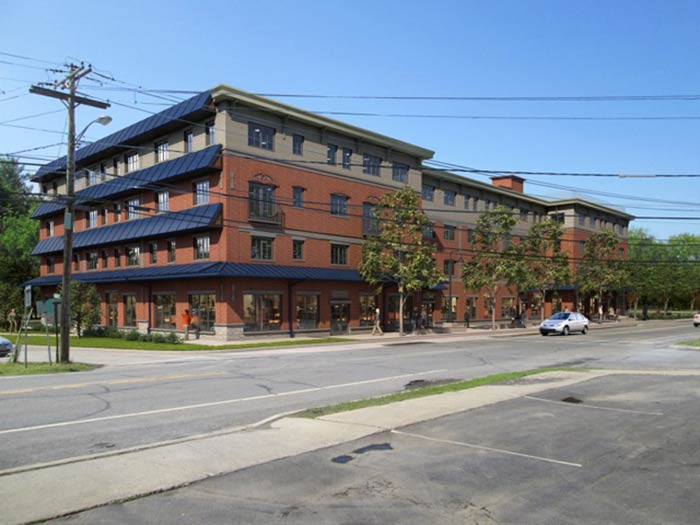
Rendering of Zero Place from the corner of Mulberry Street and Route 32 North. (David Shepler)
Some village of New Paltz residents aren’t expressing confidence in the “expanded EAF” strategy that New Paltz Village Planning Board members have undertaken to resolve environmental issues with Zero Place, and said as much during the board’s November 1 meeting. The Zero Place proposal is for a mixed-use building to be constructed on the empty lot at the corner of Mulberry and North Chestnut streets. It would include 48 apartments over a floor of retail space; the entire structure is intended to be net-zero in regard to energy usage, hence the name. Board members have opted to hold off voting on the project’s environmental significance, which would trigger a series of strict deadlines as an in-depth environmental impact statement was prepared.
The impacts upon Historic Huguenot Street (HHS)should not be underestimated, warned that organization’s board chair, Mary Etta Schneider. “Most other communities that have national historic resources, such as HHS, embrace them. They assure visibility, proper signage, traffic control and easy access to sites. . . . the best-known towns for history want their historic resources to be visible, not hidden behind a wall of tall buildings.”
Schneider went on to note that while Zero Place is a single building, “it is precedent-setting.” Schneider’s concern about building height is echoed by others who belong to the Friends of New Paltz group, as this is the first project under NBR zoning, which includes a 50-foot maximum height. Other buildings in the village are typically restricted to 35 feet.
Neighbor Cara Lee told board members she detected a “sense of conflict” as they weighed the zoning rules for the NBR, which stands for neighborhood-business-residential, and environmental standards. Board members had agreed that Zero Place would represent something that’s significantly different, but it’s exactly the type of difference envisioned by the architects of the new zoning, including the late planning board chairman Maurice Weitman. “Don’t feel confused,” Lee said to board members, because “both are in play.”
Jo Margaret Mano hearkened back to a letter sent to board members by Nan Stolzenburg, a planner who has written some of the workbooks used to navigate the process outlined in the State Environmental Quality Review act, or SEQR for short. In that letter, Stolzenburg questioned using the answers to long-form questions in the environmental assessment form as the mitigation, rather than as a tool for identifying what must be mitigated. Mano further urged board members to take a “broad view of community character,” and evaluate the cumulative impact of smaller issues together.
The idea of the “expanded EAF” is to allow the applicant to revisit areas of concern and propose mitigation measures in an effort to eliminate those red flags without diving into the formal EIS process. As board chairman Michael Zierler explained it, a vote to make a positive declaration of significance — which would trigger the need for an EIS — could be made at any time. “A pos-dec is not being excluded,” he said. Attorney Richard Golden is expected to recommend an exact process at the November 15 board meeting, but it’s not clear how much more public input will be requested. “There’s already been a lot of public input,” Zierler explained, and the areas of concern appear clear. On the other hand, it “might be more efficient to have a public hearing” at some point during the process, regardless.

How much in property tax as?
Where are the dumpsters?
The sewage plant went right below the history section of town in 1969 and is still there. I would get rid of that first
In 1998, a 50′ tall, 54 apartment complex went in next to the park and swimming pool on the same street this project is on the corner of. This project sets no building height precedence? How tall is the church steeple?
The assisted living business park has buildings 50′ tall. Built 2009 by the same planning board.
What an obnoxious poorly, and cheaply designed monster! Tack on a solar panel and call yourself a hero! Ha! This monstrosity has no place in that section of New Paltz. The stone houses are right there, They should be ashamed.
Do they Pledge Alegiance to The Flag? The michrophone is 30 feet away and we don’t hear it?
This type of large scale dense apartment building belongs in the city of Kingston or Poughkeepsie, not in the village of New Paltz. This build is located at one of the entrances to the Historic Huguenot Street stone houses and does nothing to preserve the simple historic character of that part of the village.
I understand the need for affordable housing, but this is not going to be affordable for families. It will also become a traffic nightmare for that section of town since there is not adequate parking available for residents, visitors, business consumers, and business employees.
Audacity, more audacity and always audacity!
Wild Bill Hickcock is playing poker at The Saloon, when a straner walks in, and says “This game is stacked!” Wild Bill shoots him.
Moral- Jack of Diamonds is a hard card to play.
exactly conforms to the Village’s zoning statute and net-zero emissions to boot. Build it.
Ever been to Boston? Lots and lots of historic buildings near newer and taller ones and….wait for it…..lots of people know the old buildings are there and actually visit! Yup! Old and new working together! I hear there are LOTS of places where historic places are near new buildings!
I am excited to see this village grow and lead the development path rather than be left behind!!!!
BUILD NOW!!!! Empty lots help no one!!!!!!